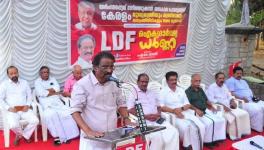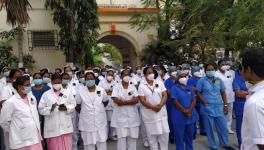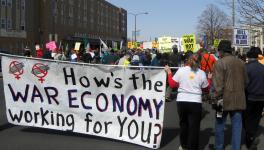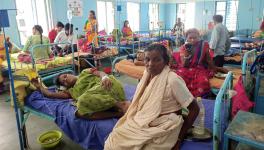Finance Commission Recommendations for Cities Extremely Paltry

Representational image. | Image Courtesy: flickr
The road map for the next five years for devolution of funds to the states as recommended by the 15th Finance Commission (XVFC) is ready. The XVFC has met in the last few years and the previous year was the year of Covid pandemic and natural corollary-lessons to be learnt. However, the recommendations of the XVFC tends to belie the aspirations of the states and the people from getting a due share.
The structure of recommendations reduces devolution on the basis of need and equity, and leaves a larger share under the discretionary powers of the Union. This has hit the federal spirit and for the first time in the running commentary, one finds mention of the states’ responsibility to the sovereign-for a national cause; “………State finances have become a crucial lynchpin of India's fiscal framework. Overall, as stipulated by the FRBM Act, 2003 (as amended in 2018), we believe that the States must partner with the Union Government in pursuit of medium-term consolidation of debt and firmly place India's sovereign debt to GDP ratio on a sustainable footing in the medium term. They must partner with the Union Government in developing new ways to support their residents, the economy as a whole and India's global engagements. Hence, the debt and fiscal trajectory of the general government envisages this partnership of both the Union and the States to achieve the key features of macroeconomic stabilisation by way of sustainable levels of debt and fiscal deficit.”
This has also been effectively done by taking a share of the states. The funds devolved on the basis of need and equity has fallen from 92.5% to 75% of the total, leaving a staggering 25% to be devolved based on “efficiency” and “performance”.
Much has been written on this aspect; I, rather, would like to focus on the recommendations of the XVFC and the urban. The urban is nearly 34% of the population and contributes 67% of the GDP. It was expected that after witnessing ghastly scenes of the inequity-led reverse migration of the workers from the cities during the lockdown, the FC recommendations would put greater emphasis to this aspect. However, this aspect remained unnoticed by the commission. Then, let us see what is there for the urban in the recommendations.
But before going into that, it is also important to note that the two quotes made by the commission at the beginning of the main report are contradictory to each other. The first one is Mahatma Gandhi’s quote where it states that “the future depends on what we do in the present”. The focus is on planning and why present is more important. The second one is from the Roman philosopher Marcus Aurelius: “Never let the future disturb you. You will meet it, if you have to, with the same weapons of reason which today are you against the present.” Apparently, the XV FC report is also quite contradictory to the quotes. Whereas in the running commentary it mentions the unusual times and the challenges posed by Covid, in the effective part it recommends the reverse instead of ameliorating the current concerns.
Let us see how it figures in the urban recommendations. Though the total outlay for urban areas is more than the XIV FC, in actual terms status quo has been maintained.
The total outlay by the XIV commission was Rs 87,144 crore and 15% of this was not released. Hence, the actual amount spent was Rs 74,529 crore. The total outlay for the urban local bodies for the period 2021-26 is Rs 1,21, 055 crore. However, the outlay for 2021 is lesser than 2020. It has dipped from Rs 25,098 crore to Rs 22,114 crore – a decline of 11.71%.
The criteria for grants to local bodies is that the grants will be distributed amongst states based on their population and area, with 90% and 10% weightage, respectively. There are two conditions for availing these grants: firstly, the local bodies will have to publish provisional and audited accounts; secondly, fixation of minimum floor rates of property taxes by states and improvement in the collection of property taxes. Grants will not be released to local bodies after March 2024 if the state does not constitute a State Finance Commission and act upon its recommendations.
The XVFC has categorically stated that “we recommend the provision of a one-year window for notifying the floor rates of property tax; this will trigger in two stages from 2022-23. In the first stage, States are expected to notify the floor rates and operationalise the arrangements in 2021-22. The condition of notifying the floor rates of property tax will apply for eligibility of grants from 2022-23. Once the floor is notified, the condition of growth in property tax collection being at least as much as the simple average growth rate of the State's own GSDP in the most recent five years will be measured and taken into account from 2023-24 onwards.”
Another fund called the ‘challenge fund’ is opened up for million-plus cities; this will be linked to the performance of these cities in improving air quality and meeting service level benchmarks, urban drinking water supply, sanitation and solid waste management. The total fund under this head is Rs 26,057 crores for five years.
XVFC MISSES THE CORE
The XVFC missed the core element in the devolution of funds. As pointed out in the beginning, addressing the issue of equity and the transformation of the large informal sector to almost 93% in the cities is an important challenge. Here are a few missed points:
Firstly, the devolution of a mere 11% is too meagre to meet any of the challenges the cities face today. According to a high-powered committee set up by the Ministry of Urban Development in 2011, annual urban infrastructure investment requirements in 2013 were estimated to be Rs 50,000 crore, which would become Rs 4 lakh crore by 2032. These figures amount to nearly 0.75% of the GDP in 2012 -13 and to 1.5% in 2032. Presently the total outlay from the XVFC and the Union budget for such investment is just 0.19%, and that of urban grants a meagre 0.07% of the GDP. Over the period, the combined expenditure of urban local bodies in the country has been continuously shrinking from 1.74% of GDP in 1990 to nearly 1% in 2011.
The memorandum of the Union Ministry of Housing and Urban Affairs submitted to the XVFC sums the requirements of the municipalities: “A substantial increase in grants is needed for bridging the resource gap of municipalities, which is anticipated at Rs. 12.27 lakh crore over the period 2021-22 to 2025-26. Devolution to municipalities may be increased by at least four times (Rs. 3,48,575 crore), as compared to the FC-XIV award.”
Secondly, the paranoia over the collection of property tax and linking it to availing the grant must be given up. No doubt that the property tax is one of the important sources of resource mobilisation in the municipalities, but to over centralise it would be erroneous. The provision for asking the state governments to decide the floor area rate for property tax is completely flawed. Every town and city have a different capacity, and even intra-city there are differences in property appreciation. This task must be left to the municipalities and not to the state governments. In fact, the best practices must be followed in ensuring the collection of property tax. Besides, the previous year has been a year of disaster for the people and for a large number of businesses. A complete waive off of property taxes, especially for the hospitality industry, and in lieu of that, a grant could have been a better option.
Thirdly, the same mistakes, as in the past, of considering cities to be the engines of growth continue to plague the XVFC. Since the UN-Habitat III, there has been a concerted effort to focus on sustainability goals and not to treat cities as market entrepreneurs. We have seen how unsustainable our cities have become with humongous inequity being spread rampantly. The effort should have been to check that. Unfortunately, the recommendations continue with the same jargon and intent. Take for example the language of the document- creating model PPP contracts, modernising municipal budgeting, evolving national municipal borrowing framework including provisions equivalent to the Fiscal Responsibility and Budget Management Act for urban local bodies; all these points at the same mindset of cities being converted into attractive investment zones.
These insinuations are berserk. Not realising the fact that nearly 90% of the urban local bodies are unable to even meet their salary expenditure, such recommendations are complete insanity. Further, the XVFC did not pay heed to the inequity widening in the cities; according to Oxfam, the marginalisation of the poor has shot up rapidly.
Fourthly, in such a situation, the XVFC was expected to create a separate fund for the urban employment guarantee or likewise to address acute unemployment existing in the cities--akin to what it has recommended on pollution and air quality.
HEALTH INTERVENTION
The XVFC recommendations on the health sector and granting an outlay of Rs 70,051 crore is a welcome move. Taking a cue from the Kerala experience, which is affirmatively quoted in the report, the commission has admired the people’s plan of the Kerala government started in 1996, where 35-40% of the state government’s developmental budget was marked to local governments.
Universal comprehensive healthcare is planned to be provided through urban health and wellness centres and polyclinics. Linking it with the urban local bodies is a welcome move. The state governments must provide space and capacity for this idea to bloom, and as the pandemic has proven, the public health institutions stand as saviours. How this will be effectively implemented in absence of both will and resources, that will have to be watched keenly in the coming years.
Get the latest reports & analysis with people's perspective on Protests, movements & deep analytical videos, discussions of the current affairs in your Telegram app. Subscribe to NewsClick's Telegram channel & get Real-Time updates on stories, as they get published on our website.
























